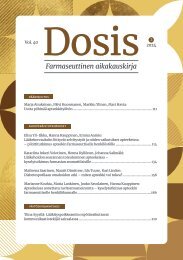DOSIS 1/2021
Farmaseuttinen aikakauskirja DOSIS 1/2021 vol.37 5uomen Farmasialiitto ry
Farmaseuttinen aikakauskirja DOSIS 1/2021 vol.37 5uomen Farmasialiitto ry
Create successful ePaper yourself
Turn your PDF publications into a flip-book with our unique Google optimized e-Paper software.
Summary<br />
Transition to a centralized<br />
drug distribution model in<br />
an internal medicine ward:<br />
Experiences from a pilot project<br />
Hanne Ahtiainen*<br />
MSc (Pharm)<br />
HUS Pharmacy, Helsinki University Hospital<br />
hanne.ahtiainen@helsinki.fi<br />
Terhi Vanhalakka<br />
BSc (Pharm)<br />
HUS Pharmacy,<br />
North Kymi Hospital<br />
Anna-Riia Holmström<br />
PhD, MSc (Pharm), Assistant professor<br />
HOH Helsinki One Health<br />
Faculty of Pharmacy<br />
Faculty of Veterinary Medicine<br />
University of Helsinki<br />
Raisa Laaksonen<br />
Senior lecturer, PhD,<br />
Adjunct professor in clinical pharmacy<br />
Division of Pharmacology and Pharmacotherapy<br />
Faculty of Pharmacy<br />
University of Helsinki<br />
Marja Airaksinen<br />
PhD, MSc (Pharm), Professor<br />
Clinical Pharmacy Group,<br />
Division of Pharmacology and Pharmacotherapy<br />
Faculty of Pharmacy<br />
University of Helsinki<br />
* Correspondence<br />
Introduction<br />
A large proportion of medication errors<br />
reported in hospitals can be attributed to the<br />
drug distribution process. Many Finnish hospitals<br />
use the traditional ward stock system, a<br />
decentralized drug distribution model, where<br />
nurses or pharmacists located on the ward dispense<br />
individualized patient doses from each<br />
ward’s drug stock, either manually or with<br />
help of automated solutions, such as an automated<br />
dispensing cabinet. In contrast, centralized<br />
drug distribution systems are popular<br />
internationally, due to comparative advantages<br />
with respect to efficiency and patient safety. In<br />
a centralized model, drugs are dispensed into<br />
individualized patient doses prior to leaving the<br />
hospital pharmacy. The aim of this study was<br />
to investigate (1) how a centralized drug distribution<br />
model may affect medication management<br />
processes; (2) impact on medication<br />
safety for inpatients, and (3) implications to be<br />
considered when adopting a new drug distribution<br />
model.<br />
Materials and Methods<br />
A centralized drug distribution process was<br />
implemented on an internal medicine ward to<br />
facilitate this pilot study. For each pilot patient<br />
on the ward, the centralized hospital pharmacy<br />
dispensed a 24 hour supply of drugs into<br />
a specialized medication cart. In addition to<br />
drugs dispensed by an automated multi-dose<br />
drug dispensing system, the pharmacy dispensed<br />
individual patient doses of oral solutions,<br />
injectable drugs, and PRN (as needed)<br />
drugs into the cart. A comparison study examined<br />
the detection rates of patient medication<br />
errors, before and during the pilot. A survey<br />
with open-ended questions on medication<br />
safety and the centralized drug distribution<br />
model was completed by nursing staff participants.<br />
A qualitative analysis was conducted on<br />
survey responses.<br />
Results<br />
Nurses (n=10/12) agreed that drug and patient<br />
safety was improved by adopting a centralized<br />
drug distribution model. Respondents reported<br />
that the administration of drugs to patients<br />
was easier, as this part of the process could be<br />
performed in an uninterrupted ward round.<br />
However, the large physical size of the medication<br />
cart was not compatible with smaller<br />
sized patient rooms. Pharmacists monitored<br />
medication charts for 13 weekdays prior to the<br />
intervention, and for 12 weekdays during the<br />
centralized drug distribution pilot. Medication<br />
errors decreased from 9.1% to 8.0% with the<br />
centralized drug dispensing. During the pilot,<br />
the pharmacist had more time to review patient<br />
medication charts, and medication errors were<br />
found only 3.4% of medication charts (before<br />
pilot 5.3%).<br />
Conclusions<br />
In drug therapy, hospital pharmacy automation<br />
combined to centralized drug distribution<br />
can improve inpatient safety by increasing<br />
accuracy and efficiency in several ways, including<br />
transcribing, dispensing and administering<br />
drugs in the hospital wards. From ward staff<br />
perspective, the centralized drug dispensing<br />
simplified the medication management process,<br />
and pharmacists and nurses had more<br />
time to focus on their clinical responsibilities.<br />
When implementation is successful, the centralized<br />
drug dispensing may reduce the incidence<br />
of medication errors in wards. Attention<br />
should be paid to the correctness of patient<br />
medication charts, and the maximum dosage<br />
for any PRN drugs. Change management process<br />
is crucial to the successful adoption of a<br />
new drug distribution model. It is important<br />
to ensure that all personnel have an adequate<br />
understanding of the new drug dispensing system<br />
and medication risk management.<br />
Keywords: Drug therapy, medication<br />
errors, medication systems, hospital,<br />
medication reconciliation, pharmacy<br />
service, program development<br />
Sidonnaisuudet<br />
Ei sidonnaisuuksia.<br />
66 Dosis Vol. 37 1/<strong>2021</strong> © Suomen Farmasialiitto ry Suomen Farmasialiitto ry © 1/<strong>2021</strong> Vol. 37 Dosis 67

















